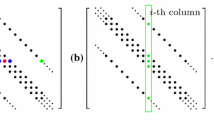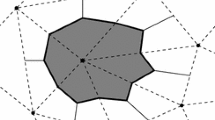Abstract
Transient flows through porous media can be controlled by local capillary forces. In an attempt to ease the representation of these complex multi-scale flows, this article presents a new numerical approach to account for these local forces, viewed as a global pressure discontinuity acting in bi-fluid flows through smeared-out porous media. A finite element discretization of the Darcy’s equations is considered and a pressure enriched space is locally introduced at the fluid interface in order to capture the pressure discontinuity. Then, a Variational Multiscale Stabilization (VMS) method is selected to take into account the subgrid effects on the finite element solution and hence ensure the consistency of the finite element formulation. The fluid front is represented by a level set function, convected with the fluid velocity thanks to a finite element scheme stabilized with a Streamline-Upwind/Petrov-Galerkin (SUPG) method. Both convergence and implementation are first validated with the Method of Manufactured Solution (MMS) and the model shows a good convergence. Second, a comparison with experimental measurements in the case of capillary wicking of water into carbon reinforcements shows a very good correlation between experimental and numerical results.















Similar content being viewed by others
References
Aarnes J, Heimsund B (2005) Multiscale discontinuous galerkin methods for elliptic problems with multiple scales. In: Engquist B, Runborg O, Lötstedt P (eds) Multiscale methods in science and engineering. Springer, Berlin, pp 1–20
Abouorm L, Blais M, Moulin N, Bruchon J, Drapier S (2014) A robust monolithic approach for resin infusion based process modelling. Key Eng Mater 611–612:306–315
Abouorm L, Troian R, Bruchon J, Drapier S (2014) Stokes/Darcy coupling in severe regimes using multiscale stabilization for mixed finite element: monolithic approach versus decoupled approach. Eur J Comput Mech 23:113–137
Afkhami S, Zaleski Z, Bussman M (2009) A mesh-dependent model for applying dynamic contact angles to vof simulations. J Comput Phys 228:5370–5389
Ahn KJ, Seferis JC, Berg JC (1991) Simultaneous measurements of permeability and capillary pressure of thermosetting matrices in woven fabric reinforcements. Polym Compos 12:146–152
Ausas R, Buscaglia G, Idelsohn SR (2011) A new enrichment space for the treatment of discontinuous pressures in multi-fluid flows. Int J Numer Methods Fluids 70:829–850
Badia S, Codina R (2009) On a multiscale approach to the transient Stokes problem: dynamic subscales and anisotropic space-time discretization. Appl Math Comput 207:415–433
Badia S, Codina R (2009) Unified stabilized finite element formulations for the Stokes and the Darcy problems. SIAM J Numer Anal 47:1971–2000
Badia S, Codina R (2010) Stabilized continuous and discontinuous Galerkin techniques for Darcy flow. Comput Methods Appl Mech Eng 199:1654–1667
Badia S, Codina R (2012) Stokes, Maxwell and Darcy: a single finite element approximation for three model problems. Appl Numer Math 62:246–263
Baer TA, Cairncross RA, Schunk PR, Rao RR, Sackinger PA (2000) A finite element method for free surface flows of incompressible fluids in three dimensions. Part II: dynamic wetting lines. Int J Numer Methods Fluids 33:405–427
Bastian P (2014) A fully-coupled discontinuous Galerkin method for two-phase flow in porous media with discontinuous capillary pressure. Comput Geosci 18:779–796
Benazzouk L, Arquis E, Bertrand N, Descamps C, Valat M (2013) Motion of a liquid bridge in a capillary slot: a numerical investigation of wettability and geometrical effects. La Houille Blanche 3:50–56
Blais M, Moulin N, Liotier PJ, Drapier S (2017) Resin infusion-based processes simulation: coupled Stokes-Darcy flows in orthotropic preforms undergoing finite strain. Int J Mater Form 10(1):43–54
Brackbill JU, Kothe DB, Zemach C (1992) A continuum method for modeling surface tension. J Comput Phys 100:335–354
Bréard J, Saouab A, Bouquet G (2003) Numerical simulation of void formation in lcm. Composites: Part A 34:517–523
Brooks AN, Hughes T (1982) Streamline upwind/Petrov-Galerkin formulations for convection dominated flows with particular emphasis on the incompressible Navier-Stokes equations. Comput Methods Appl Mech Eng 32 (1):199–259
Buscaglia G, Ausas R (2011) Variational formulations for surface tension capillarity and wetting. Comput Methods Appl Mech Eng 200(45-46):3011–3025
Carraro T, Wetterauer S (2016) On the implementation of the eXtended finite element method (XFEM) for interface problems. Arch Numer Softw 4(2):1–23
Celle P, Drapier S, Bergheau JM (2008) Numerical modelling of liquid infusion into fibrous media undergoing compaction. Eur J Mech A Solids 27(4):647–661
Chessa J, Belytschko T (2003) An eXtended finite element method for two-phase fluids. Trans ASME 70:10–17
Chevalier L, Moulin N, Liotier P-J, Bruchon J, Drapier S (2018) Accounting for local capillary effects in two-phase flows with relawed surface tension formulation in enriched finite elements. Comptes Rendus Mécanique 346(8):617–633
Codina R (2000) On stabilized finite element methods for linear systems of convection-diffusion-reaction equations. Comput Methods Appl Mech Eng 182:61–82
Coppola-Owen H, Codina R (2005) Improving eulerian two-phase on finite element approximation with discontinuous gradient pressure shape functions. Int J Numer Methods Fluids 49:1287–1304
Coupez T, Silva L, Hachem E (2015) Implicit boundary and adaptive anisotropic meshing. Springer International Publishing, Switzerland, pp 1–18
Darcy H (1856) Les fontaines publiques de la ville de Dijon. Victor Dalmont, Paris
Dereims A, Drapier S, Bergheau JM, De Luca P (2015) 3D robust iterative coupling for Stokes, Darcy and solid mechanics for low permeability media undergoing finite strains. Finite Elem Anal 94:1–15
Discacciati M, Hacker D, Quarteroni A, Quinodoz S, Tissot S, Wurm FM (2013) Numerical simulation of orbitally shaken viscous fluids with free surface. Int J Numer Methods Fluids 71(3):294–315
Fumagalli A, Scotti A (2014) An efficient XFEM approximation of Darcy flows in arbitrarily fractured porous media. Oil Gas Sci Technol 69(4):555–564
Ganesan S, Matthies G, Tobiska L (2007) On spurious velocities in incompressible flow problems with interfaces. Comput Methods Appl Mech Eng 196:1193–1202
Gatica GN, Oyarzua R, Sayas FJ (2011) Analysis of fully-mixed finite element methods for the Stokes-Darcy coupled problem. Math Comput 276:1911–1948
Govignon Q, Bickerton S, Kelly PA (2010) Simulation of the reinforcement compaction and resin flow during the complet resin infusion process. Compos A: Appl Sci Manuf 41(1):45–57
Guasch O, Codina R (2007) An algebraic subgrid scale finite element method for the convected Helmholtz equation in two dimensions with applications in aeroacoustics. Comput Methods Appl Mech Eng 196:4672–4689
Helmig R, Weiss A, Wohlmuth BI (2007) Dynamic capillary effects in heterogeneous porous media. Comput Geosci 11(3):261–274
Hughes TJR (1995) Multiscale phenomena: Green’s functions, the Dirichlet-to-Neumann formulation, subgrid scale models, bubbles, and the origins of stabilized methods. Comput Methods Appl Mech Eng 127:387–401
Hughes TJR (1998) The variational multiscale method—a paradigm for computational mechanics. Comput Methods Appl Mech Eng 166(1–2):3–24
Idelsohn SR, Gimenez JM, Marti J, Nigro N (2017) Elemental enriched spaces for the treatment of the weak and strong discontinuous fields. Comput Methods Appl Mech Eng 313:535–559
Idelsohn SR, Gimenez JM, Nigro N (2018) Multifluid flows with weak and strong discontinuous interfaces using an elemental enriched space. Int J Numer Methods Fluids 86(12):750–769
Idelsohn SR, Mier-Torrecilla N, Nigro N, Onate E (2010) On the analysis for heterogenous fluids with jumps in the viscosity using a discontinuous pressure field. Comput Mech 46(1):115–124
Jung Y, Kim SJ, Han WS (2013) Numerical simulation of RTM process using the extended finite element method combined with the level set method. J Reinf Plast Compos 32:308–317
Koubaa S, Burtin C, Le Corre S (2016) Investigation of capillary impregnation for permeability prediction of fibrous reinforcements. J Compos Mater 50(11):1417–1429
Krauss D (2011) Two-phase flow in homogeneous porous media—the role of dynamic capillary pressure in modeling gravity driven fingering. Master’s thesis, Stuttgart University
Lee S, Wheeler MF (2018) Enriched Galerkin methods for two-phases flow in porous media with capillary pressure. J Comput Phys 367:65–86
Li M, Wang SK, Gu YZ, Potter K, Zhang ZG (2012) Evaluation of through-thickness permeability and the capillary effect in vaccum assisted liquid molding process. Compos Sci Technol 72(8):873–878
Liu Y, Wang L, Liu X, Ding T (2014) Effects of capillary pressure—fluid saturation—relative permeability relationships on predicting carbon dioxide migration during injection into saline aquifers. Energy Procedia 63:3616–3631
Masoodi R, Pillai KM (2012) Wicking in porous materials—traditional and modern approaches. CRC Press, Boca Raton
Masud A, Hughes TJR (2002) A stabilized mixed finite element method for Darcy flow. Comput Methods Appl Mech Eng 191(25–28):4341–4370
Michaud V, Mortensen A (2001) Infiltration processing of fibre reinforced composites: governing phenomena. Composites: Part A 32:98–996
Minev PD, Chen T, Nandakumar K (2003) A finite element technique for multifluid incompressible flow using Eulerian grids. J Comput Phys 187:255–273
Monlaur A, Fernandez-Mendez S, Huerta A (2008) Discontinuous Galerkin methods for the Stokes equations using divergence-free approximations. Int J Numer Methods Fluids 57:1071–1092
Osher S, Fedkiw RP (2000) Level set methods: an overview and some recent results. J Comput Phys 169(2):463–502
Pacquaut G, Bruchon J, Moulin N, Drapier S (2012) Combining a levet-set method of mixed stabilized p1/p1 formulation for coupling Stokes-Darcy flows. Int J Numer Methods Fluids 69(2):459–480
Park CH, Lebel A, Saouab A, Bréard J, Lee W (2011) Modeling and simulation of voids and saturation in liquid composite molding processes. Compos A: Appl Sci Manuf 42(6):658–668
Pierce RS, Falzon BG, Thompson MC (2017) A multi-physics process model for simulating the manufacture of resin—infused composite. Compos Sci Technol 149:269–279
Pino Muñoz D, Bruchon J, Drapier S, Valdivieso F (2013) A finite element based level set method for fluid-elastic solid interaction with surface tension. Int J Numer Methods Eng 93(9):919–941
Pucci MF, Liotier PJ, Drapier S (2015) Capillary wicking in a fibrous reinforcement—orthotropic issues to determine the capillary pressure components. Composites/A 77:133–141
Pucci MF, Liotier PJ, Drapier S (2016) Capillary wicking in flax fabrics—effects of swelling in water. Colloids Surf A Physicochem Eng Asp 498:176–184
Roache PJ (2002) Code verification by the method of manufactured solutions. J Fluids Eng 124(1):1–4
Simacek P, Advani SG (2003) A numerical model to predict fiber tow saturation during liquid composite molding. Compos Sci Technol 63(12):1725–1736
Simacek P, Neacsu V, Advani SG (2010) A phenomenological model for fiber tow saturation of dual scale fabrics in liquid composite molding. Polym Compos 31(11):1881–1889
Toure M (2016) Stabilized finite element method for solving the level set equation without reinitialization. J Comput Math Appl 71(8):1602–1623
Verrey J, Michaud V, Manson JAE (2006) Dynamic capillary effects in liquid composite molding with non-crimp fabrics. Composite Part/A 37(1):92–102
Šikalo V, Wilhelm HD, Roisman IV, Jakirlić S, Tropea C (2005) Dynamic contact angle of spreadin droplets: experiments and simulations. Phys Fluids 17(6):062103
Wang Y, Moatamedi M, Grove SM (2009) Continuum dual-scale modeling of liquid composite molding processes. J Reinf Plast Compos 28(12):1469–1484
Washburn EW (1921) Note on a method of determining the distribution of the pore sizes in porous material. Proc Natl Acad Sci USA 7(4):115–116
Yang J, Jia Y, Sun S, Ma D, Shi T, An L (2006) Mesoscopic simulation of the impregnation process of unidirectional fibrous preform in Resin Transfer Molding. Mater Sci Eng A 435–436:515–520
Yeager M, Hwang WR, Advani SG (2016) Prediction of capillary pressure for resin flow between fibers. Compos Sci Technol 126:130–138
Zset-Software: http://www.zset-software.com/
Author information
Authors and Affiliations
Corresponding author
Ethics declarations
Conflict of interests
The authors declare that they have no conflict of interest.
Additional information
Publisher’s Note
Springer Nature remains neutral with regard to jurisdictional claims in published maps and institutional affiliations.
Rights and permissions
About this article
Cite this article
Andriamananjara, K., Moulin, N., Bruchon, J. et al. Numerical modeling of local capillary effects in porous media as a pressure discontinuity acting on the interface of a transient bi-fluid flow. Int J Mater Form 12, 675–691 (2019). https://doi.org/10.1007/s12289-018-1442-3
Received:
Accepted:
Published:
Issue Date:
DOI: https://doi.org/10.1007/s12289-018-1442-3




